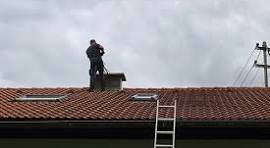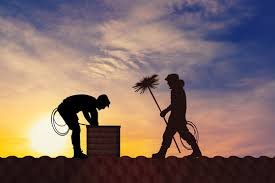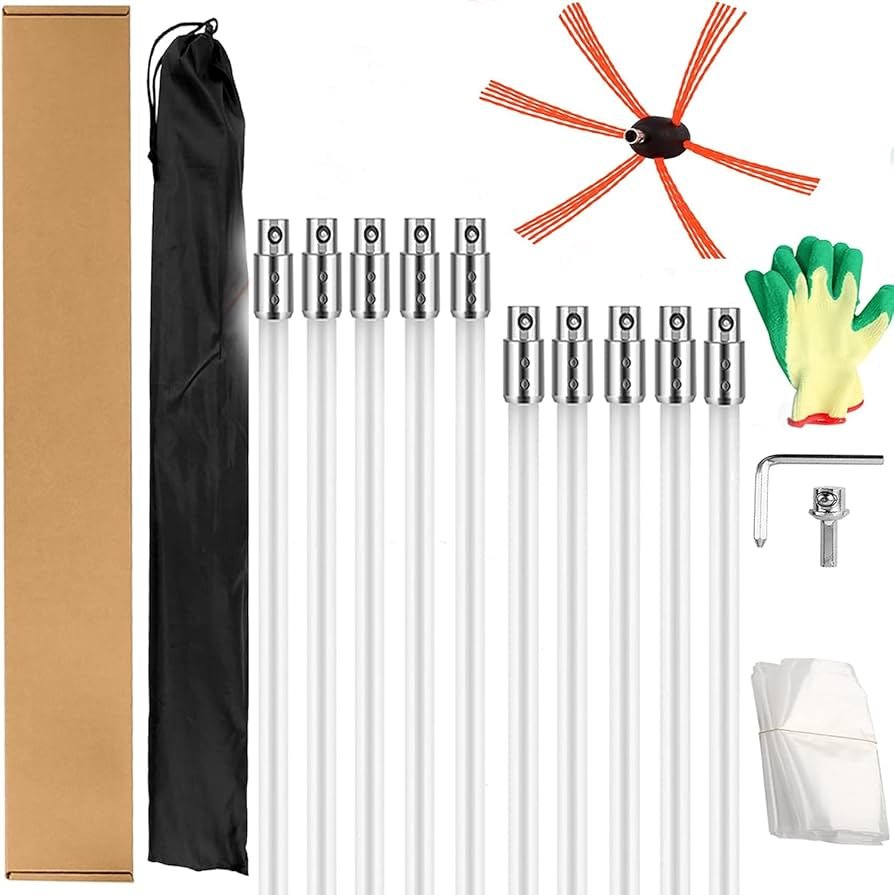Maintaining a clean chimney is essential for ensuring the safety and efficiency of your replacement or wood-burning stove. Regular cleaning helps prevent chimney repairs, improves indoor air quality, and ensures your heating system operates at peak performance. In this extensive guide, we’ll delve into the importance of chimney cleaning, provide valuable cleaning tips and tricks, and discuss the benefits of using a chimney cleaning kit. You will have all the information necessary to maintain the best possible condition for your chimney by the time you finish reading this article.

Importance of Chimney Cleaning
|Chimney Cleaning|Preventing Chimney Fires: Preventing chimney fires is one of the most important justifications for routine cleaning. When you burn wood, a substance called creosote forms on the inner walls of your chimney. Creosote is highly ammable, and if not removed regularly, it can ignite and cause a dangerous chimney fire. Regular cleaning removes this buildup, reducing the risk significantly.
|Chimney Cleaning|Improving Efficiency: A clean chimney allows smoke and gases to exit your home efficiently. Soot and creosote buildup in the chimney can restrict air flow, reducing the efficiency of your stove. You can make sure that your heating system performs at its peak efficiency by keeping the chimney clean
|Chimney Cleaning|Enhancing Air Quality: A blocked or dirty chimney can lead to smoke and harmful gases, such as carbon monoxide, entering your living space. This not only affects indoor air quality but can also pose serious health risks. Ensuring that these hazardous gases are appropriately ventilated out of your house requires routine cleaning.
|Chimney Cleaning|Extending the Life of Your Chimney: Regular maintenance and cleaning can extend the life of your chimney. Removing corrosive byproducts and preventing the buildup of harmful substances helps preserve the integrity of your chimney, reducing the need for costly repairs.
Chimney Cleaning Tips and Tricks
Proper cleaning involves more than just running a brush through the urine. Here are some essential cleaning tips and tricks to ensure a thorough job:
|Chimney Cleaning|Schedule regular inspections:Even if you clean your chimney yourself, it’s important to have it inspected by a professional annually. A professional can identify potential issues that you might miss, such as cracks, leaks, or structural damage.
|Chimney Cleaning|Use the right tools. Invest in a high-quality cleaning kit that includes a variety of brushes, rods, and protective gear. Make sure the brushes are the right size for your chimney, and use exible rods to navigate any bends or offsets. Wear protective gear. Cleaning can be messy and hazardous. Always wear safety goggles, gloves, and a dust mask to protect yourself from soot and debris.
|Chimney Cleaning|Lay down protective coverings: Before you start cleaning, lay down drop cloths or tarps around the floor to protect your floors and furniture from falling soot and debris.
|Chimney Cleaning|Clean from the Top Down: Clean the chimney from the top down if you have access to the roof and it’s safe to do so. This method allows gravity to help with the removal of debris. Use a push-pull motion to scrub the walls of the chimney with the brush.
|Chimney Cleaning|Check the Chimney Cap: Ensure that the chimney cap is in good condition and free of debris. A damaged or clogged cap can lead to blockages and reduce the effectiveness of your cleaning efforts.
Monitor Smoke Output: Keep an eye on how much smoke your stove or replacement is producing. Excessive smoke can indicate a problem with your chimney, such as a blockage or poor draft.
Burn Seasoned Wood: Use only dry, seasoned wood in your replacement or stove. Wet or green wood produces more creosote, increasing the frequency of cleaning required.
Install a Chimney Cap: A chimney cap prevents debris, animals, and rain from entering your chimney. This reduces the need for frequent cleaning and protects your chimney from damage. Be thorough. Don’t rush the cleaning process. Take your time to ensure that all parts of the chimney, including the smoke chamber and UE, are thoroughly cleaned.

Benefits of Using Chimney Cleaning Kit
Using a cleaning kit can make the cleaning process more efficient and effective. Here are some benefits of using a cleaning kit:
Comprehensive Tools: The cleaning kit typically includes a variety of brushes and rods designed to tackle different types of chimneys and buildup. This ensures that you have the right tools for the job.
Flexibility: The exible rods included in chimney cleaning kits allow you to navigate bends and offsets in the chimney, ensuring a thorough clean throughout the entire unit.
Cost-effective: Investing in a cleaning kit can save you money in the long run. By performing regular cleanings yourself, you reduce the need for frequent professional services.
Convenience: You may clean your chimney whenever it’s convenient for you using a chimney cleaning kit. This is especially beneficial if you use your stove frequently and need more regular cleanings.
Safety: To protect you throughout the cleaning procedure, many cleaning kits include protective gear like gloves and goggles.

How Do You Choose the Right Chimney Cleaning Kit?
When selecting a chimney cleaning kit, consider the following factors to ensure you get the best one for your needs:
Chimney size and type: Measure the dimensions of your chimney to ensure you get the right brush size. If your chimney has bends or offsets, exible rods are essential.
Brush Material: Wire brushes are more durable and effective for heavy creosote, while plastic brushes are less abrasive and suitable for regular maintenance.
Rod Length and Flexibility: Ensure the rods are long enough to reach the entire length of your chimney and flexible enough to navigate any bends.
Quality and Durability: Invest in a high-quality kit that will last through multiple cleanings. Seek out kits with robust brushes and rods. Additional Accessories: Some kits come with additional accessories, such as chimney caps, vacuums, or inspection cameras. Consider these extras if they meet your needs and budget.
Step-by-Step Guide to Using a Kit
Using a cleaning kit effectively involves several steps. To assist you with the procedure, below is an extensive guide:
Step 1: Prepare Your Work Area Lay down drop cloths or tarps around the floor to protect your floors and furniture. Keep the air flowing properly by opening the doors and windows.
Step 2: Assemble Your Tools Put on your protective gear, including goggles, gloves, and a dust mask. Assemble the chimney brush and rods according to the manufacturer’s instructions.
Step 3: Inspect the Chimney Use an ashlight to inspect the inside of the chimney for any obstructions or damage. If you notice any significant issues, such as a blocked window or structural damage, consider calling a professional.
Step 4: Cleaning from the Top Down Cleaning the chimney from the top down is safe to undertake if you have access to the roof. Move the brush back and forth within the chimney to clean the walls. Add additional rods as needed to reach the full length of the chimney.
Step 5: Cleaning from the Bottom Up If roof access is not possible, clean the chimney from the bottom up. Attach the brush to the rods and insert it into the replacement. Use a similar push-pull motion to scrub the chimney walls, adding rods as needed.
Step 6: Clean Up After brushing, use a vacuum or dust collector to clean up any soot and debris that has fallen into the replacement. Remove the drop cloths or tarps carefully to avoid spreading soot.
Step 7: Final Inspection Inspect the chimney one last time to ensure it is clean and free of obstructions.

Common Mistakes to Avoid When Using a Chimney Cleaning Kit
Using a chimney cleaning kit can be straightforward, but it’s essential to avoid common mistakes that can compromise the effectiveness of your cleaning or even cause harm. Here are some important things to be wary of:
Skipping protective gear: Always wear safety goggles, gloves, and a dust mask. Creosote and soot can irritate your eyes, skin, and respiratory system.
Neglecting to Cover Surroundings: Failing to use drop cloths or tarps can result in a messy home. Soot and debris can spread quickly and be difficult to clean from carpets and furniture.
Improper Brush Size: Using the wrong size brush can either miss areas that need cleaning or get stuck on Page 1 of 2 in the chimney. Measure your nails accurately, and choose a brush that fits snugly.
Forgetting to Check the Chimney Cap: Ensure that the chimney cap is secure and free of debris before and after cleaning. A damaged cap can allow animals and debris to enter, leading to blockages.
Not Inspecting the Chimney Regularly: Regular inspections help identify issues early. Don’t rely solely on annual cleanings; visually inspect your chimney frequently during the burning season.
Ignoring Professional Help: Cost worries may prevent some homeowners from hiring an expert. However, professionals can identify and resolve issues that a basic cleaning kit may not address.

DIY vs Professional Chimney Cleaning
DIY Cleaning
Pros:
Cost-effective: Buying a cleaning kit and doing the work yourself can save money over time.
Convenience: You can clean your chimney on your schedule without waiting for an appointment.
Learning Experience: Gaining knowledge and skills in home maintenance can be satisfying.
Cons:
Time-consuming: Cleaning can take several hours, especially for beginners.
Safety Risks: Working on a roof or dealing with creosote carries inherent risks. Limited
Effectiveness: DIY kits may not reach all areas or handle severe buildup as effectively as professional tools.
Professional Cleaning
Pros:
Expertise: Professionals have the training to handle complex chimney systems and identify potential issues.
Efficiency: A professional cleaning is often quicker and more thorough. Safety: Professionals are equipped to work safely at heights and deal with hazardous materials.
Cons:
Cost: Hiring a professional can be more expensive, especially if additional repairs are needed.
Scheduling: You may need to wait for an available appointment, which can be inconvenient during peak seasons.
Maintenance Tips for a Healthy Chimney
Annual Inspections: Obtain a professional annual inspection for your chimney, even if you clean it yourself. They are able to identify any issues that you might overlook. Install smoke and carbon monoxide detectors. These sensors are essential for identifying issues early on. Make sure to install them close to your sleeping quarters and replace them.
Check for draft problems: Make sure the draft in your chimney is right. The chimney is where smoke should go, not inside your house. Draft issues can often be resolved by adjusting the damper or adding a chimney cap.
Clean the Fireplace or Stove: Regularly remove ashes and debris from your replacement or wood stove. Excessive ash can affect the air and contribute to creosote buildup.
Use Proper Firewood: Only burn dry, seasoned wood. Avoid using treated or painted wood, which can release harmful chemicals.
Keep the Area Clear: Ensure that the area around your replacement or stove is clear of ammable materials. This lowers the possibility of unintentional reactions.
Creosote and Its Dangers
A tar-like material known as creosote is produced when wood doesn’t burn completely. It adheres to the inner walls of your chimney and can
become a significant hazard. What you should know about creosote is as follows:
Stages of Creosote Buildup:
Stage 1: A light, aky deposit that can be easily brushed away.
Stage 2: A crunchy, tar-like deposit that is more difficult to remove and requires more aggressive cleaning.
Stage 3: A thick, glaze-like coating that is extremely hard and requires professional removal. This stage is highly amicable and poses a significant risk.
Preventing Creosote Buildup:
Use Seasoned Wood: Moisture in wood contributes to creosote formation. Use wood that has been dried for at least six months.
Maintain Proper Air Flow: Ensure your replacement or stove is getting enough air to burn fuel completely.
Regular Cleaning: Frequent cleaning reduces the amount of creosote buildup.
Excessive Smoke: More smoke than usual could indicate a creosote problem.
Burning smell: A strong, tar-like odour can be a sign of significant creosote buildup.
Visible Soot and Tar: Check the inside of your chimney for visible soot and tar deposits.
Regular chimney maintenance is crucial for the safety, efficiency, and longevity of your replacement or wood-burning stove. Cleaning, whether done by a professional or using a cleaning kit, is essential for preventing dangerous chimney risks and maintaining a healthy indoor environment. By following the cleaning tips and tricks outlined in this guide, you can ensure your chimney remains in excellent condition, providing warmth and comfort for your home throughout the year. Remember, a well-maintained chimney not only enhances the performance of your heating system but also safeguards your home and family from potential hazards.



